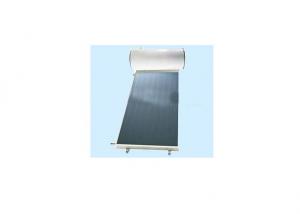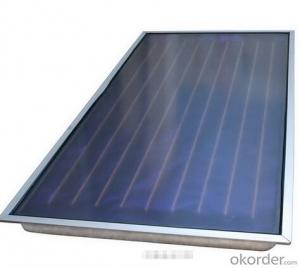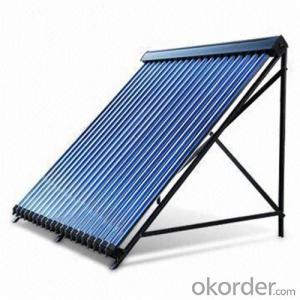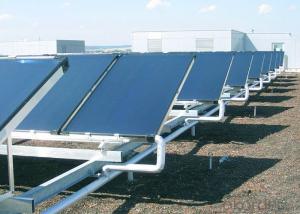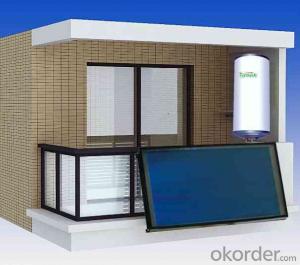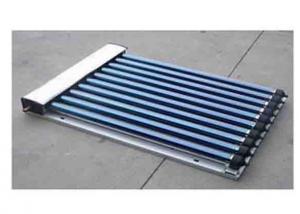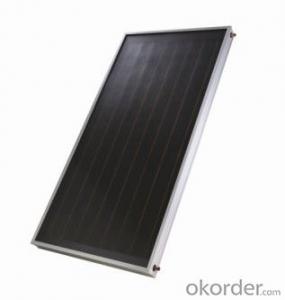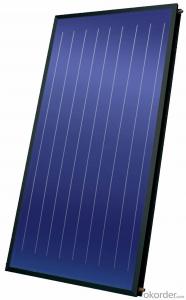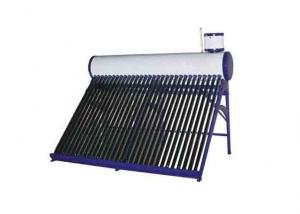Photovoltaic Solar Monocrystalline Series Panels
- Loading Port:
- Tianjin
- Payment Terms:
- TT OR LC
- Min Order Qty:
- 1 pallet
- Supply Capability:
- 100000000 pallet/month
OKorder Service Pledge
OKorder Financial Service
You Might Also Like

Product Description:
Solar Monocrystalline Series Panels
Introduction of Solar Monocrystalline Series Panels
CNBM Solar photovoltaic (PV) Panel is designed for large electrical power requirements. It is the optimal choice for both on-grid and off-grid power systems. CNBM Solar panel offers high performance of power per square foot of solar array. Monocrystalline silicon(c-Si): often made using the Czochralski process. Single-crystal wafer cells tend to be expensive, and because they are cut from cylindrical ingots, do not completely cover a square solar cell module without a substantial waste of refined silicon. Hence most c-Si panels have uncovered gaps at the four corners of the cells.
Characteristics of Solar Monocrystalline Series Panels
I Solar Cell : High efficiency crystalline solar cell. Even if under the weak light, the solar module can produce maximum power output.
II Tempered glass (toughened glass): Anti-reflecting coating and high transmission rate glass increase the power output and mechanical strength of solar module.
III EVA and TPT: Using high quality EVA and TPT to prevent destroying and water.
IV AI frame: Without screw, corner connection. 6 holes on the frame can be installed easily.
V Junction box: Multi function junction box with water proof.
VI Long lifetime: ≥25 years; Less power decrease
VII Good performance of preventing from atrocious weather such as wind and hails.
VIII Resisting moisture and etching effectively, not effected by geology.
Standard Test Conditions of Solar Monocrystalline Series Panels
The opto-electrical specifications shown below are stabilized values being measured at Standard Test Conditions, Irradiance: 1000W/m2, Spectrum: AM1.5 at 25°C, The info below is subject to manufacturing tolerances. Where appropriate minutes of measurement are available and are used for the dimensioning of the installation.
Advantages of Solar Monocrystalline Series Panels
• CNBM Solar performance guarantees for 25 years
• 12 years guarantee for workmanship
• Timeliness of delivery
CNBM International Corporation's products including Monocrystalline Solar Panel, Polycrystalline Solar Panel have received and enjoyed famous reputation in many countries and regions in the world .As a solar panel supplier in China, we strive to provide our customers with excellent service, superior products and unmatched value.
Characteristics of Solar Monocrystalline Series Panels
Max Power Voltage Vmp (V) | 18.4V | 17.6V |
Max Power Current Imp (A) | 6.52A | 7.39A |
Open Circuit Voltage Voc (V) | 23.0V | 22.2V |
Short Circuit Current Isc (A) | 6.97A | 7.90A |
Max Power Pm (W) | 120W | 130W |
Temperature Coefficient of Cells
NOCT | 47℃±2℃ |
Temperature Coefficients of Isc (%/℃) | 0.064 |
Temperature Coefficients of Voc (%/℃) | -0.33 |
Temperature Coefficients of Pmp (%/℃) | -0.45 |
Mechanical Data Solar Monocrystalline Series
Power | 120W/130W |
Dimension | 1190/1470×670×30mm |
Weight | 9.5kg/11.7kg |
Tolerance | ±3% |
The dimension of the modules can be changed according to the demand of clients
Limits
Operating Temperature | –40 °C to +85°C |
Storage Temperature | –40 °C to +85°C |
Max System Voltage | 700V |
Guarantee Solar Monocrystalline Series Panels
Products Guarantee | 10 yrs free from defects in materials and workmanship |
Performance Guarantee | No less than 90% within 10yrs and no less than 80% within 25yrs |
Certificates | IEC, ISO, TUV, CE |
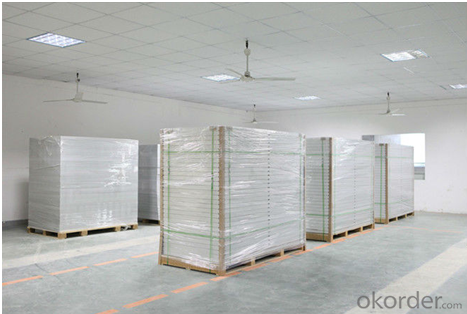
FAQ
We have organized several common questions for our clients,may help you sincerely:
1. What’s price per watt?
A: It’s depends on the quantity, delivery date and payment terms of the order. We can talk further about the detail price issue. Our products is high quality with lower price level.
2. Can you tell me the parameter of your solar panels?
We have different series of cells with different power output, both from c-si to a-si. Please take our specification sheet for your reference.
3. How do you pack your products?
We have rich experience on how to pack the panels to make sure the safety on shipment when it arrives at the destination.
4. Can you do OEM for us?
Yes, we can.
5. How long can we receive the product after purchase?
In the purchase of product within three working days, We will arrange the factory delivery as soon as possible. The perfect time of receiving is related to the state and position of customers. Commonly 7 to 10 working days can be served.
- Q:Can solar collectors be used for heating outdoor seating areas?
- Yes, solar collectors can be used for heating outdoor seating areas. Solar collectors can convert sunlight into heat energy, which can then be used to warm up outdoor seating areas. This can provide a sustainable and cost-effective solution for heating outdoor spaces without relying on traditional energy sources.
- Q:What is the ideal tilt angle for a solar collector?
- The ideal tilt angle for a solar collector depends on various factors such as the geographical location, season, and specific application. However, a commonly recommended tilt angle for solar collectors is typically equal to the latitude of the installation site. This helps maximize the amount of sunlight received throughout the year.
- Q:Can solar collectors be used for generating electricity on public transportation systems?
- Public transportation systems can indeed utilize solar collectors for electricity generation. These devices, also referred to as solar panels or photovoltaic (PV) panels, convert sunlight into electrical energy through the photovoltaic effect. They can be conveniently installed on various parts of public transportation systems, including roofs, sides, and even integrated into windows. By making use of solar energy, public transportation systems can reduce their dependence on fossil fuels and lower their carbon footprint. The generated electricity can power various components of the transportation system, such as lighting, air conditioning, and even electric vehicle charging stations. Additionally, any surplus electricity can be stored in batteries for later use during periods of limited sunlight, ensuring a continuous supply of power. The integration of solar collectors on public transportation systems offers several advantages. Firstly, it reduces operational expenses by reducing the need for external sources of electricity. This can result in substantial long-term savings, particularly for larger transportation systems. Secondly, it promotes sustainability and environmental friendliness by utilizing clean and renewable energy sources. This helps combat climate change and enhances air quality in urban areas. Furthermore, the presence of solar panels on public transportation systems can serve as a visible symbol of eco-friendly initiatives, raising awareness and encouraging individuals to adopt more sustainable practices. It can also inspire other transportation systems to follow suit and implement similar renewable energy solutions. While certain challenges need to be considered, such as initial investment costs and limited space for solar panel installation on certain vehicles, technological advancements and decreasing costs of solar panels are making this solution increasingly feasible. With careful planning and design, solar collectors can play a critical role in generating electricity for public transportation systems, contributing to a cleaner and more sustainable future.
- Q:Can solar collectors be used for heating car manufacturing plants and assembly lines?
- Certainly, solar collectors can be utilized to heat car manufacturing plants and assembly lines. By harnessing the sun's energy and converting it into heat, solar thermal collectors offer a versatile solution for heating industrial facilities. Implementing solar collectors on the rooftops or open areas of car manufacturing plants allows for the effective utilization of collected solar energy to complement or replace conventional heating systems. Solar thermal collectors operate by absorbing sunlight through tubes or panels containing a heat-absorbing medium, such as water or a heat-transfer fluid. This absorbed heat can then be transferred to various heating systems, such as radiators, underfloor heating, or even the facility's ventilation system. This process ensures a comfortable working environment for employees and fulfills the heating requirements of assembly lines. Furthermore, solar collectors can be integrated with other energy-efficient technologies, like heat pumps or thermal storage systems, to optimize the usage of solar energy. These additional systems store excess heat during sunny periods and release it when needed, guaranteeing a continuous supply of heating energy even on cloudy days or at night. The utilization of solar collectors for heating car manufacturing plants and assembly lines offers several advantages. Firstly, it reduces dependence on fossil fuels and helps mitigate the environmental impact associated with greenhouse gas emissions. Secondly, it leads to considerable cost savings on energy bills, as sunlight is a free and abundant source of energy. Additionally, the integration of solar collectors into manufacturing facilities enhances their sustainability profile and contributes to the organization's overall corporate social responsibility efforts. However, it is essential to consider various factors, including geographical location, available installation space, and energy requirements of the facility, to determine the feasibility of using solar collectors for heating car manufacturing plants and assembly lines. A comprehensive assessment and feasibility study should be conducted to establish the optimal design, size, and integration of solar thermal systems to meet the specific heating needs of each manufacturing plant or assembly line.
- Q:Can solar collectors be used for cooking?
- Yes, solar collectors can be used for cooking. Solar cookers harness the energy from the sun and convert it into heat, allowing for the cooking or heating of food.
- Q:Can solar collectors be used in conjunction with other renewable energy systems?
- Yes, solar collectors can definitely be used in conjunction with other renewable energy systems. In fact, combining different renewable energy technologies can enhance the overall efficiency and reliability of the energy system. Solar collectors, also known as solar thermal systems, can be integrated with various other renewable energy systems such as wind turbines, hydroelectric power plants, and geothermal systems. This combination allows for a more diverse and balanced energy generation portfolio. One way to combine solar collectors with other renewable energy systems is through hybrid systems. For instance, solar collectors can be used in conjunction with wind turbines to create a hybrid renewable energy system that utilizes both solar and wind power. This can be particularly useful in areas where there is fluctuating availability of sunlight or wind. Another example is combining solar collectors with geothermal systems. Geothermal energy relies on the heat stored in the earth's crust, while solar collectors capture the sun's thermal energy. By integrating these two systems, it is possible to achieve a more consistent and reliable energy supply, as geothermal energy can provide a stable base load while solar collectors can supplement during peak demand periods. Furthermore, solar collectors can also be used in conjunction with other renewable energy technologies to improve overall energy efficiency. For instance, excess heat generated by solar collectors can be used to power absorption chillers for cooling or to provide heat for industrial processes. This way, solar collectors can help to maximize the utilization of renewable energy resources and reduce waste. In conclusion, solar collectors can be successfully combined with other renewable energy systems to create hybrid systems that enhance energy generation efficiency and reliability. By integrating different renewable energy technologies, we can create a more sustainable and resilient energy infrastructure for the future.
- Q:Are there any limitations to the size of a solar collector installation?
- Indeed, the size of a solar collector installation is subject to various limitations. One such limitation pertains to the space available for installation. The installation of solar collectors necessitates a certain amount of space, and if the available area is restricted, the installation of a large-scale solar collector system may not be feasible. Another limitation concerns the quantity of sunlight or solar radiation accessible in a specific location. The electricity or heat generation of solar collectors relies on sunlight, so if an area experiences limited sunlight throughout the year, the installation of a large-scale solar collector system may not be practicable. Moreover, the cost associated with the installation and maintenance of a large-scale solar collector system can impose limitations. Larger installations necessitate more equipment, materials, and labor, thereby increasing the overall cost. Furthermore, the cost of maintaining, repairing, and cleaning a larger system may also be higher, potentially constraining the size of the installation. Additionally, limitations may arise from the electrical grid capacity and infrastructure. If the local electrical grid lacks the capacity to accommodate the additional energy generated by a large-scale solar collector system, connecting it to the grid may not be possible. Upgrading the grid infrastructure can be both costly and time-consuming, thereby restricting the size of the installation. Lastly, regulatory and zoning restrictions can also impact the size of a solar collector installation. Local regulations and zoning laws may impose constraints on the size or height of solar collector installations, thereby limiting their scale. In summary, while solar collector installations can be expanded to a certain extent, factors such as available space, sunlight availability, cost, electrical grid capacity, and regulatory constraints can impose limitations on their size.
- Q:Can solar collectors be used for heating disaster relief areas?
- Yes, solar collectors can be used for heating disaster relief areas. They can provide a sustainable and reliable source of heat by converting sunlight into thermal energy. This can be particularly beneficial in disaster-stricken areas where traditional heating methods may be unavailable or unreliable. Solar collectors offer an environmentally friendly and cost-effective solution to provide warmth and comfort to those in need during relief efforts.
- Q:Can solar collectors be used in areas with strict building regulations?
- Yes, solar collectors can generally be used in areas with strict building regulations. However, the specific regulations and restrictions may vary depending on the location. It is important to consult with local authorities and adhere to any specific guidelines or permits required for installing solar collectors in such areas.
- Q:Can solar collectors be used to generate steam for industrial processes?
- Yes, solar collectors can be used to generate steam for industrial processes. Solar thermal systems, such as concentrated solar power (CSP) plants, use mirrors or lenses to concentrate sunlight onto a receiver, which then heats up a fluid such as water or oil to generate steam. This steam can be utilized in various industrial applications, including power generation, heating, and industrial processes that require high-temperature steam.
1. Manufacturer Overview |
|
|---|---|
| Location | |
| Year Established | |
| Annual Output Value | |
| Main Markets | |
| Company Certifications | |
2. Manufacturer Certificates |
|
|---|---|
| a) Certification Name | |
| Range | |
| Reference | |
| Validity Period | |
3. Manufacturer Capability |
|
|---|---|
| a)Trade Capacity | |
| Nearest Port | |
| Export Percentage | |
| No.of Employees in Trade Department | |
| Language Spoken: | |
| b)Factory Information | |
| Factory Size: | |
| No. of Production Lines | |
| Contract Manufacturing | |
| Product Price Range | |
Send your message to us
Photovoltaic Solar Monocrystalline Series Panels
- Loading Port:
- Tianjin
- Payment Terms:
- TT OR LC
- Min Order Qty:
- 1 pallet
- Supply Capability:
- 100000000 pallet/month
OKorder Service Pledge
OKorder Financial Service
Similar products
New products
Hot products
Hot Searches
Related keywords






